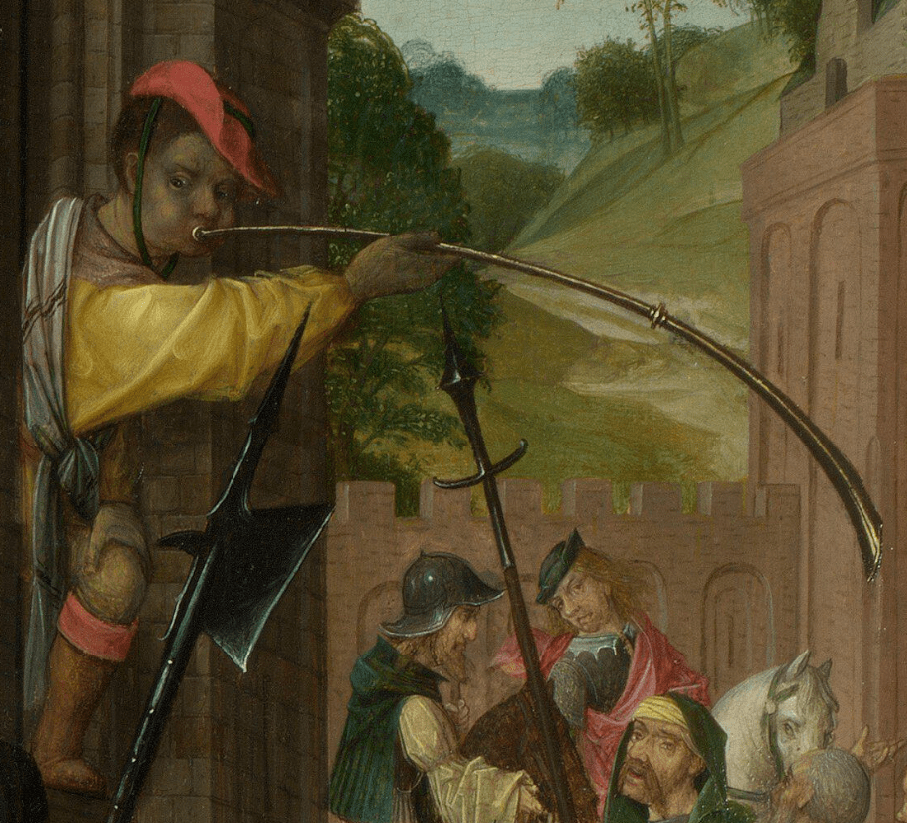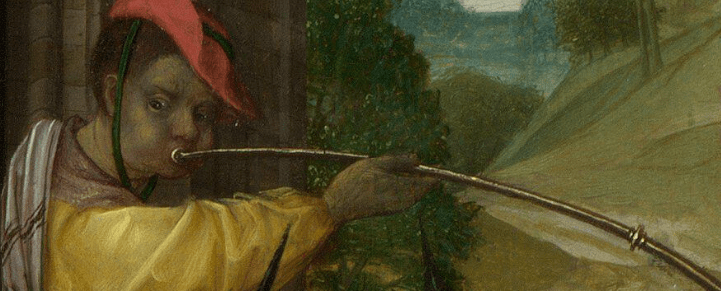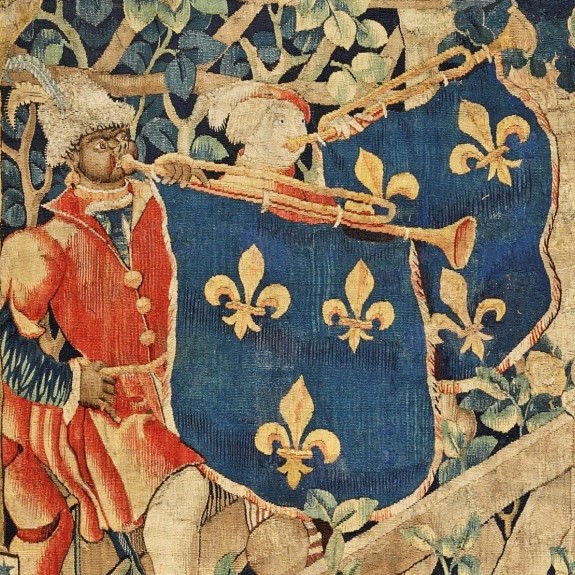Whatever is going on, it is clearly important – a trumpeter is heralding important news. Given the shadows on the slopes – and the blue remembered hills in the distance – he leans out from the very palace we saw yesterday. Stepping up onto a parapet with his left foot, he rests his left hand on his knee. His right arm stretches straight to support the long, single arc of his instrument, which, in a subtle, but charmingly artistic detail, echoes the curve of the track leading through the landscape beyond what must be the city wall. The musician looks over his right shoulder at something – or someone – just to our left, as his cheeks puff out to sound the trumpet. His dress is some way between exotic – with a striped scarf going round his left shoulder and tied under his right arm, and a bright yellow, full-sleeved tunic – and standard, however bright the broad-brimmed red hat.

Two weapons – a halberd and some form of spear – are held by people who must be in between us and the musician. Whatever the event, ceremonial or ‘actual’, it requires the presence of guards, but as the two weapons are different, and not held upright, I would think that this is not a formal occasion.

What most intrigues me about today’s detail is the fact that the artist has painted a black trumpeter. Given that there are so few people of colour represented in paintings in the National Gallery (so now you know where it is!) I am amazed that I only became aware of this man’s existence when I began looking at this work in preparation for this Lenten series. But then, that is the value of looking at anything without preconceptions. If you think you know what is there, as I thought I did, you only see what you expect. By taking the details out of context, as we are, you get more of a chance to see everything that is needed to make a painting work. As my PhD supervisor once advised me (it may have been the only advice I got), keep looking until you’ve seen everything, and can’t possibly see any more. And then look again.
As it happens, there were a number of black musicians in Western Europe in the 16th Century, one of the most notable being John Blanke, a trumpeter in the courts of Henry VII and VIII. He is the only black Tudor for whom we have an identifiable image, and we know enough about him to know that he was well-paid, and well-respected. In 1512 he successfully petitioned Henry VIII for a promotion, and his wage was doubled. In the same year he got married, and the king gave him a wedding present: a new suit of clothes, including a hat and a violet velvet gown. There are two images of him that survive, dating from 1511, in the Westminster Tournament Roll, held by the College of Arms.

If you want to know more about him, you can find almost everything there is from the Historic Royal Palaces website, on a page entitled John Blanke: A black musician at the Tudor court. Or, for that matter, you could read the entry on the same website by independent art historian Michael Ohajuru, on The Black Presence at the Tudor court.
The English Court wasn’t the only one to have black musicians. I’ll leave you for today with a tapestry illustrating a wrestling match during the infamous Field of the Cloth of Gold, a meeting between Henry VIII and François I of France, which took place in 1520. I can’t for the life of me work out who owns this tapestry now – it was sold at Sotheby’s in 2014, and may have passed through Christie’s four years later. However, it is due to feature in an exhibition at Hampton Court between 1 April and 5 September this year to mark the 501st anniversary of the event (yes, a year late because… well, you know). At the top left is another black trumpeter, with the fleur-de-lis on his banner, as if François I, watching the bout at the top right, was all-too conscious of the need to keep up with the Tudors. Maybe our musician is playing for yet another monarch…



This is great Richard, I had never realised this – was the trumpeter’s name English or perhaps French? I have refently been intrigued by Mostaert’s portrait of Christoph Le More and his re-use for images of St Maurice.
LikeLiked by 1 person
Very good point – his name is possibly French, and almost more likely to be Spanish, as he may have arrived in England in the entourage of Catherine of Aragon. It could have been an ‘ironic’ name – Blanc, or Blanco, meaning ‘White’…
LikeLike
Thanks Richard, that’s exactly what I thought, a bit like ‘Little John’ in Robin Hood and I am sure there are many other ironic names / nicknames.
LikeLiked by 1 person
I so enjoyed today’s lecture and wondered when your next one will be?
I was bowled over by the amount of information you gave us but a bit sad knowing I wouldn’t retain it all. However if I could attend all your lectures I’m sure my muscle memory will improve in time.
Thank you for such a fascinating lecture.
Gail
>
LikeLike
Thank you, Gail – the next lecture is at the same time next Monday, as per the final slide. You can find a link on the ‘diary’ page of this website, or here: https://tixoom.app/richardstemp/xl4e5eai
LikeLike
Probably a bit late to the party, but I think I have identified!
LikeLiked by 1 person
Well done – but I wouldn’t say you were late!
LikeLike
Thank you very much for today’s clue, intriguingly moving to the Courts of Henry VIII and Francois 1. Also intriguing to see the helmet – is it a Swiss guard ? Julia
LikeLike
I doubt it is the Swiss Guard, but you never know… we’ll find out soon enough, I’m sure!
LikeLike
The helmet looks to me like a sallet, transitional from a bascinet towards a burgonet. Also a nice hunting spear with crossmember, and a halberd or poleaxe.
LikeLike
Excellent – thank you! As you can probably tell, I’m OK on art, but not so great on armour…
LikeLike